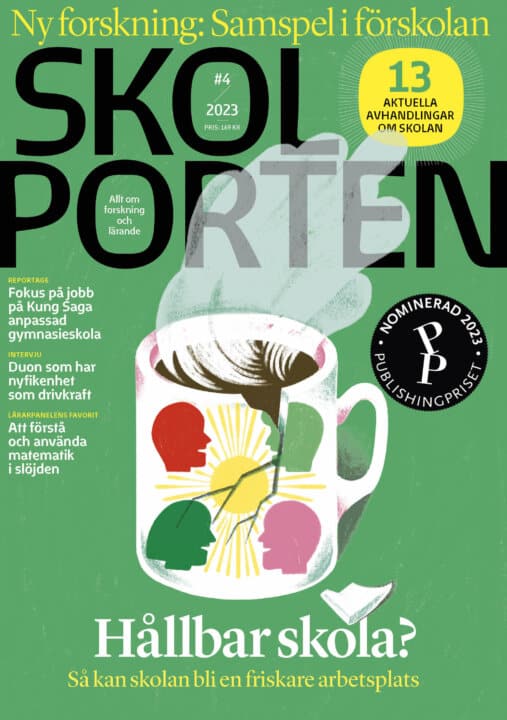Connect: Modelling learning to facilitate linking models and the real world through lab-work in electric circuit courses for engineering students
Syftet med Anna-Karin Carstensens avhandling är att ta fram en modell för lärande av ett sammansatt begrepp, och visa hur denna kan användas för analys av önskat lärandeobjekt, samt studenters aktivitet under laborationer.
Anna-Karin Carstensen
Professor Jonte Bernhard, Linköpings universitet
Professor Christian Kautz, Technische Universität Hamburg-Harburg, Tyskland
Linköpings universitet
2013-09-27
Connect modelling learning to facilitate linking models and the real world through lab-work in electric circuit courses for engineering students
Institutionen för teknik och naturvetenskap, Fysik och elektroteknik
Abstrakt
En stående fråga som lärare i naturvetenskapliga och tekniska utbildningar ställer är varför elever och studenter inte kopplar samman kunskaper från teoretiska kursmoment med den verklighet som möts vid laborationerna. Ett vanligt syfte med laborationer är att åstadkomma länkar mellan teori och verklighet, men dessa uteblir ofta. Många gånger används avancerade matematiska modeller och grafiska representationer, vilka studenterna lärt sig i tidigare kurser, men de har sällan eller aldrig tillämpat dessa kunskaper i andra ämnen. En av dessa matematiska hjälpmedel är Laplacetransformen, som främst används för att lösa differentialekvationer, och åskådliggöra transienta förlopp i ellära eller reglerteknik. På många universitet anses Laplacetransformen numera för svår för studenterna på kortare ingenjörsutbildningar, och kurser eller kursmoment som kräver denna har strukits ut utbildningsplanerna. Men, är det för svårt, eller beror det bara på hur man presenterar Laplacetransformen? Genom att låta studenterna arbeta parallellt med matematiken och de laborativa momenten, under kombinerade lab-lektionspass, och inte vid separata lektioner och laborationer, samt genom att variera övningsexemplen på ett mycket systematiskt sätt, enligt variationsteorin, visar vår forskning att studenterna arbetar med uppgifterna på ett helt annat sätt än tidigare. Det visar sig inte längre vara omöjligt att tillämpa Laplacetransformen redan under första året på civilingenjörsutbildning inom elektroteknik. Ursprungliga syftet med avhandlingen var att visa hur studenter arbetar med laborationsuppgifter, speciellt i relation till målet att länka samman teori och verklighet hur man kan förändra studenternas aktivitet, och därmed studenternas lärande, genom att förändra laborationsinstruktionen på ett systematiskt sätt. Under våren 2002 videofilmades studenter som utförde laborationer i en kurs i elkretsteori. Deras aktivitet analyserades. Speciellt studerades vilka frågor studenterna ställde till lärarna, på vilket sätt dessa frågor besvarades, och på vilket sätt svaren användes i den fortsatta aktiviteten. Detta ledde fram till en modell för lärande av sammansatta begrepp, som kunde användas både för att analysera vad studenterna gör och vad lärarna förväntar sig att studenterna ska lära sig. Med hjälp av modellen blev det då möjligt att se vad som behövde ändra i instruktionerna för att studenterna lättare skulle kunna utföra de aktiviteter som krävs för att länka teori och verklighet. Syftet med avhandlingen är därmed att ta fram en modell för lärande av ett sammansatt begrepp visa hur denna modell kan användas för såväl analys av önskat lärandeobjekt, som av studenternas aktivitet under laborationer, och därmed det upplevda lärandeobjektet använda modellen för att analysera vilka förändringar som är kritiska för studenters lärande. Modellen användes för att förändra laborationsinstruktionerna. Lärarinterventionerna inkluderades i instruktionerna på ett systematiskt sätt utifrån dels vilka frågor som ställdes av studenterna, dels vilka frågor studenterna inte noterade, men som lärarna velat att studenterna skulle använda för att skapa relationer framför allt mellan teoretiska aspekter och mätresultat. Dessutom integrerades räkneövningar och laborationer. Videoinspelningar utfördes även våren 2003, då de nya instruktionerna användes. Även dessa analyserades med avseende på studenternas aktiviteter. Skillnader mellan resultaten från 2002 och 2003 står i fokus. Avhandlingens resultatdel består av: Analys av studenternas frågor och lärarnas svar under labkursen 2002 Analys av de länkar studenterna behöver skapa för att lära Analys av laborationsinstruktionerna före och efter förändringarna Analys av den laborationsaktivitet som blev resultatet av de nya instruktionerna, och vilket lärande som då blev möjligt Avhandlingen avlutas med en diskussion om de slutsatser som kan dras angående möjligheter att via forskning utveckla modeller av undervisningssekvenser för lärande där målet är att länka samman teori och verklighet
Connect modelling learning to facilitate linking models and the real world through lab-work in electric circuit courses for engineering students
A recurring question in science and engineering education is why the students do not link knowledge from theoretical classes to the real world met in laboratory courses. Mathematical models and visualisations are widely used in engineering and engineering education. Very often it is assumed that the students are familiar with the mathematical concepts used. These may be concepts taught in high school or at university level. One problem, though, is that many students have never or seldom applied their mathematical skills in other subjects, and it may be difficult for them to use their skills in a new context. Some concepts also seem to be ”too difficult” to understand. One of these mathematical tools is to use Laplace Transforms to solve differential equations, and to use the derived functions to visualise transient responses in electric circuits, or control engineering. In many engineering programs at college level the application of the Laplace Transform is considered too difficult for the students to understand, but is it really, or does it depend on the teaching methods used? When applying mathematical concepts during lab work, and not teaching the mathematics and practical work in different sessions, and also using examples varied in a very systematic way, our research shows that the students approach the problem in a very different way. It shows that by developing tasks consequently according to the Theory of Variation, it is not impossible to apply the Laplace Transform already in the first year of an engineering program. The original aim of this thesis was to show: how students work with lab-tasks, especially concerning the goal to link theory to the real world how it is possible to change the ways students approach the task and thus their learning, by systematic changes in the lab-instructions During the spring 2002 students were video-recorded while working with labs in Electric Circuits. Their activity was analysed. Special focus was on what questions the students raised, and in what ways these questions were answered, and in what ways the answers were used in the further activities. This work informed the model ”learning of a complex concept”, which was used as well to analyse what students do during lab-work, and what teachers intend their students to learn. The model made it possible to see what changes in the lab-instructions that would facilitate students learning of the whole, to link theoretical models to the real world, through the labactivities. The aim of the thesis has thus become to develop a model: The learning of a complex concept show how this model can be used as well for analysis of the intended object of learning as students activities during lab-work, and thus the lived object of learning use the model in analysis of what changes in instruction that are critical for student learning. The model was used to change the instructions. The teacher interventions were included into the instructions in a systematic way, according to as well what questions that were raised by the students, as what questions that were not noticed, but expected by the teachers, as a means to form relations between theoretical aspects and measurement results. Also, problem solving sessions have been integrated into the lab sessions. Video recordings were also conducted during the spring 2003, when the new instructions were used. The students’ activities were again analysed. A special focus of the thesis concerns the differences between the results from 2002 and 2003. The results are presented in four sections: Analysis of the students’ questions and the teachers’ answers during the lab-course 2002 Analysis of the links students need to make, the critical links for learning Analysis of the task structure before and after changes Analysis of the students’ activities during the new course The thesis ends with a discussion of the conclusions which may be drawn about the possibilities to model and develop teaching sequences through research, especially concerning the aim to link theoretical models to the real world.
Relaterade länkar

Biologi
 Åk 7–Vux
Åk 7–Vux Hållbar utveckling i förskolan
 Fsk
Fsk 




